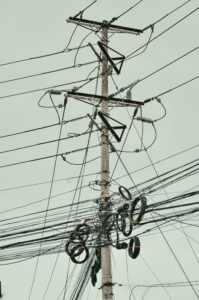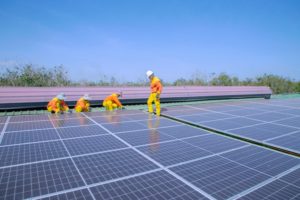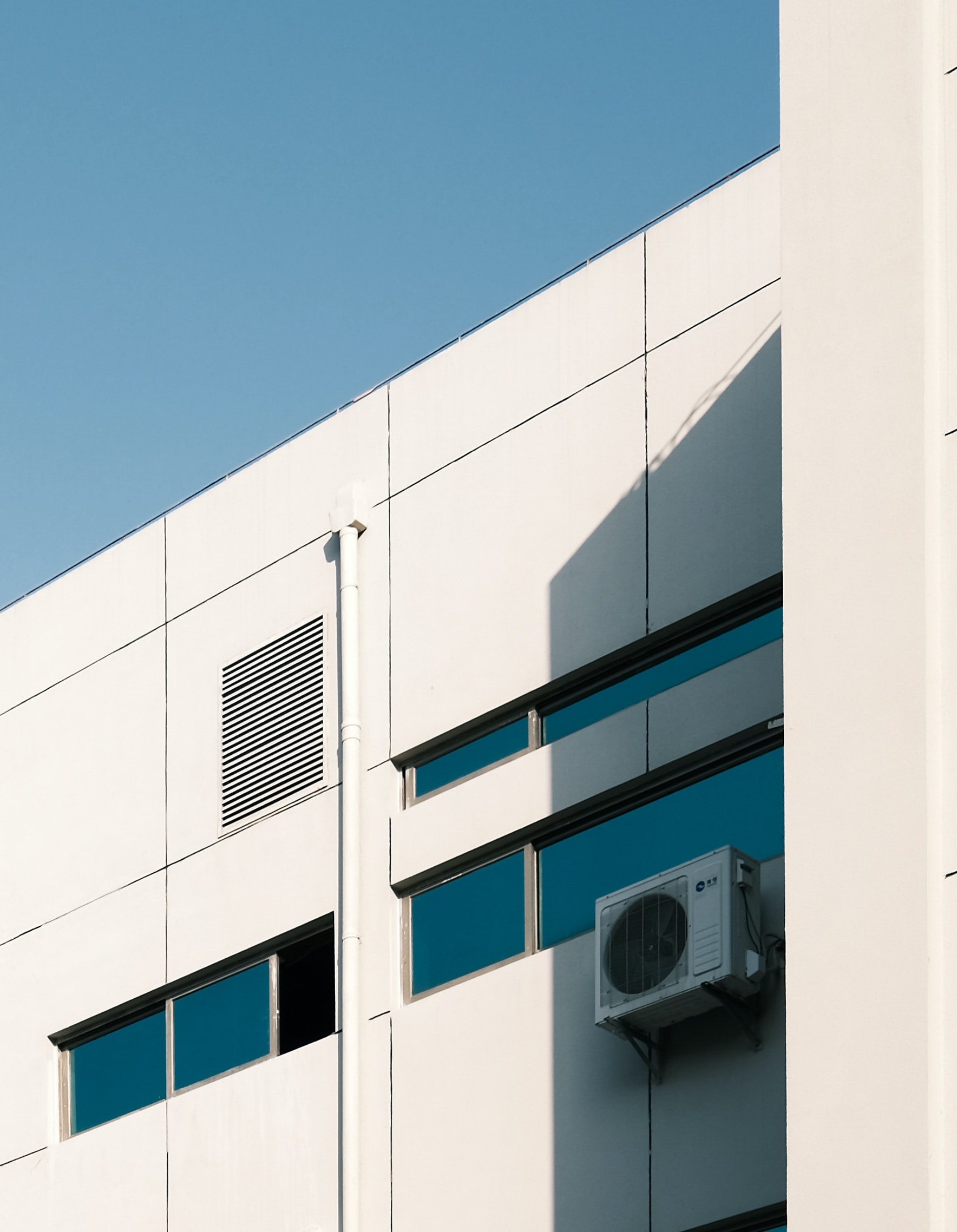Why is this important?
Energy production is responsible for 42.5% of global CO2 emissions. (1) Heating and cooling systems are responsible for 50-60% of the energy bill of hospitals and offices. (2) Energy demand for air conditioning tripled between 1990 and 2016, reaching 8.7% of total global energy demand, and it could triple again by 2050. The refrigerants contained in air conditioning equipment also contribute to global warming because of their high global warming power, between 1,300 and 3,260 times higher than CO2 for HFCs. (3)
Reducing the energy consumption of buildings means reducing their carbon footprint.
What is the solution?
Energy consumption of buildings is mainly related to heating and cooling, which are directly linked to several factors such as the desired temperature, the volume of air heated or cooled, the number of hours and the humidity of the air. By acting on these factors and adopting more sober practices, it is possible to significantly reduce energy consumption and carbon footprint of buildings.
The most ecological energy is the one that is not consumed. Adjusting the interior temperature of a building by a few degrees has a significant impact on the energy bill. Fans, plaids, curtains, carpets or blinds, common sense measures must accompany these changes.
Thermal insulation, natural ventilation or solar protection, passive energy saving measures should always be preferred to energy consuming technologies.
Choices, smart positioning, and good maintenance of heating or air-conditioning equipment also allow to reduce the energy consumed, because of a greater efficiency of the devices.
Key actions
#1 Optimise the temperature of the premises
- Allow a maximum difference of 6°C between the indoor and outdoor temperatures.
- When it is hot, air conditioning can be set at 26°C (9) without affecting the thermal comfort of the occupants.
- Regarding heating, recommended temperature for office activities is 19°C for occupied rooms, 16°C at night, 8°C if the premises are unoccupied for more than two days, and between 10 and 12 ℃ for storage and archives.
- For domestic hot water, temperature of water heaters can be programmed between 50°C and 55°C. Be careful, below 50 °C, bacteria can grow.
- Manage operating hours of the appliances according to needs, to reduce consumption at night or on weekends for example. It is possible to associate timers and thermostats to appliances to better regulate temperatures. (10)
#2 Reduce the volume of heated or cooled air
- Heat or cool only rooms that need it: in unused or low-use rooms, temperatures do not need to follow the same thermal comfort standards.
- Reduce the loss of heated or cooled air volume by insulating the building, reducing air infiltration or leaks.
- Close windows when appliances are on.
#3 Manage indoor air humidity
- The more humid the air, the higher the temperature felt by the occupants when it is hot and the lower when it is cold. Health professionals consider ideal humidity level for a house to be between 40 and 65%. Below, air that is too dry can be harmful to human health. Above, humid air is difficult to tolerate, leading users to increase heating or air conditioning.
- To maintain an acceptable level of humidity, buildings should be well ventilated at least 10 minutes a day and be airtight. Humidity absorbers (salt trays) or electric dehumidifiers can also help.
#4 Focus on passive alternatives
- Before investing in expensive heating and air conditioning systems, identify and implement passive measures that can influence the building temperature without using energy-consuming equipment.
- Use fans (which use 100 times less energy than air conditioners) and controlled mechanical ventilation (CMV) where appropriate.
- In hot climates or during summer, use solar protection on most exposed openings or walls (sunshades, blinds, shutters, shade nets).
- Use curtains, carpets, blankets, and sweaters in cold climates.
- Ventilate buildings during cooler hours in summer and warmer hours in winter.
- Paint roofs and exterior walls white to reflect sunlight and prevent heat absorption, or vegetate them, which protects against solar radiation and improves roof insulation.
- Vegetate around facilities to cool the air and provide shade.
- Use natural ventilation techniques (earth tubes, solar chimneys).
- Insulate buildings (inside or outside, with double air-separated walls and double glazing).
- Insulate hot water pipes. In the case of water heating, losses through poorly insulated or uninsulated pipes can reach 30 to 40% of the energy consumption of the heating equipment. One meter of uninsulated water pipe at 70 ℃, 25 mm in diameter, dissipates about 60 W.
#5 Choose equipment wisely
- Choose heating and air-conditioning equipment that consumes little energy and regularly monitor consumption.
- Choose low-energy or high-energy performance equipment, such as solar equipment(11), heat pumps(12), heat-reversing air conditioners or soft heat inertia radiators(13). A heat pump gives back 3 kWh of heat or cold for 1 kWh consumed. This is more than any electric radiator or conventional air conditioner, which generally consume a lot of energy. Some technologies are particularly innovative, such as seawater cooling. (14)
- Use robust labels for the choice of appliances (such as Energy Star).
- The most efficient boilers are condensing boilers, with an efficiency that can reach 102 to 108% on the lower calorific value (LCV). They provide energy savings of 25 to 30% compared to a 25-year-old boiler.
#6 Position equipment properly
- Properly positioning equipment will reduce heat loss/cooling and maximise its usefulness to occupants.
- Avoid placing appliances in a draught, as thermostats may malfunction.
- Install the units where they will be most useful, i.e., relatively close to permanent occupants (office workers).
- Prefer exterior walls to fix the devices. These walls are often cooler/warmer, and their surface size can quickly cool/heat a room.
- Stay close to a window. Radiators installed underneath can, for example, limit the effect of thermal bridges on the room temperature.
- Install air conditioners high up on walls, away from any heat source, and do not expose outdoor units to direct sunlight.
- Clear the space in front of units. For an air conditioner to be effective, it is important that it can radiate its heat/cooling perfectly. It should not be hidden behind furniture. For example, a radiator should be placed about 10-15 cm from the floor. A minimum gap of 15 cm on the sides is also necessary.
#7 Maintain equipment properly
- Taking care of and maintaining equipment will help preserve its energy performance and extend its life. Poor maintenance can reduce the efficiency of cooling units by up to 5% and shorten their life span. Regular maintenance of a heating appliance ensures its efficiency, and therefore reduces electricity consumption in relation to the heat supplied. (15)
- Plan the maintenance and servicing of the units as soon as they are purchased (internal expertise or external service provider).
- Check air filters regularly.
- Replace appliances that are too defective and, where appropriate, negotiate a maintenance contract with an obligation to achieve results.
- Take responsibility for the end-of-life of equipment. The refrigerant gases contained in air conditioners, which have a high global warming potential, should be given special attention when decommissioning equipment.
#8 Support change and raise awareness among users
- Make users aware of the issues (energy, climate, bills) and good practices (windows, shutters, thermostats, jumpers, additional sources of heat).
- Prevent wastage of heating and air conditioning (additional electric heating, open windows while appliances are on).
- Make the changeover a pleasant moment (offer a blanket or jumper, offer teleworking on cold/hot days, offer hot chocolate).
- Share the energy saving results with the staff and encourage them to do the same at home.

To consider
-
Potential co-benefits
- Reduced energy bills
- Less pressure on the electricity grid and reduced global risk of power cuts
-
Success conditions
- Support from building occupants
- Installations carried out by competent professionals
-
Prerequisites and specificities
- Where possible, establish a complete thermal diagnosis of the building, to prioritise, specify and reliably cost the expected results of the most suitable technical solutions
- There is no single solution, the measures must be chosen according to the situation
-
Potential risks
- Excessive temperature reduction in winter or setting the temperature too high in summer can have negative consequences on the occupants health, their motivation, well-being and efficiency
Point of attention
-
Point of attention
The temperature in health centres or hospitals has a direct effect on the well-being and recovery of patients. According to a study by BMC Public Health, the installation of heating, ventilation or air conditioning improves the recovery of patients and increases the effectiveness of treatments. (16)
Tools and good practices
-
CEREMA guide: simple and concrete actions for the management of real estate assets
This book offers managers of tertiary buildings simple, economical solutions that require little work to improve and optimise energy and budgetary expenses in buildings, while ensuring their quality of use. Lighting, heating, ventilation... all energy-consuming items are covered (in French)
Read here -
Advice sheets on energy performance in offices, ADEME
This website contains solution sheets, advice for action, key figures, tools and resources on lighting, ventilation and air conditioning, heating, electrical equipment, and buildings (in French)
Read here -
Air conditioning energy efficiency in tropical regions, the Francophone Institute of Energy and the Environment
Volume I, entitled Design of New Buildings, is devoted to heat balances assessment, overall operating costs of the building, and sizing and selection of an air conditioning system. Volume II, which deals with the operation of existing installations, presents different measures that can be carried out to improve energy efficiency of buildings. It describes the traditional technical approach, while introducing the innovative concept of energy performance contracting in building maintenance (in French)
Read here -
Renovation plan for the cold production of the hospital of Tourcoing
This plan presents in detail the objectives, design and project management elements, heat recovery and energy gains. One of the main objectives of this large-scale project being to reduce the energy consumption of the buildings (in French)
Read here - Hospital acts for the planet, Guide to good sustainable development practice for health and care facilities, 2015 (in French)
-
Sizing tool for solar air conditioners, ARUP
To go further
-
Heating and air conditioning: challenges and opportunities in France, Europe and the world
The increasing number of cold snaps and heat waves, as well as the long life of poorly performing buildings already built, already foreshadow the many challenges ahead. Reducing CO2 emissions, improving thermal comfort and maintaining the stability of the electrical grid are all challenges to be met. Given the current technology mix and the magnitude of future heating and cooling needs, the potential for improving energy efficiency and reducing CO2 emissions is substantial (in French)
Read here -
Passive systems for energy saving in buildings in tropical climate
A model building was designed, meeting the requirements of a tropical climate. An energy simulation was performed to compare the thermal behaviour and thermal comfort conditions of the model building under different cases of passive systems: thermal mass, solar shading, cross ventilation, and dehumidification.
Read here
Energy consumption of buildings

Energy and buildings

Sources
(1) International Energy Agency, Energy saving actions by EU citizens could save enough oil to fill 120 super tankers and enough natural gas to heat 20 million homes, 2022. Read here.
(2) Hohne, P.A., Kusakana, K., and Numbi, B.P., Improving Energy Efficiency of Thermal Processes in Healthcare Institutions: A Review on the Latest Sustainable Energy Management Strategies, 2020. Read here.
(3) Climate and Clean Air Coalition, Hydrofluorocarbons (HFCs). Read here.
(4) ADEME, Lowering the heating set point temperature. In French. Read here.
(5) International Energy Agency, Energy saving actions by EU citizens could save enough oil to fill 120 super tankers and enough natural gas to heat 20 million homes, 2022. Read here.
(6) Coolingfanreview, Air conditioner vs fan electricity usage, 2023. Read here.
(7) ADEME, Heating. In French. Read here.
(8) Hohne, P.A., Kusakana, K., and Numbi, B.P., Improving Energy Efficiency of Thermal Processes in Healthcare Institutions: A Review on the Latest Sustainable Energy Management Strategies, 2020. Read here.
(9) Tham, S. et al., Indoor temperature and health: a global systematic review, 2020. Read here.
(10) ADEME, Reduce your heating bill with a programmable thermostat, 2020. In French. Read here.
(11) French Ministry of Energy Transition, Solar, 2023. In French. Read here.
(12) ADEME, Heat pumps, 2022. In French. Read here.
(13) IZI by EDF, How to choose an inertia radiator?, 2022. In French. Read here.
(14) Reseau Chu, Seawater air-conditioning, The Reunions University Hospital is a pioneer, 2019. In French. Read here.
(15) Xpair, 20 facts to optimise heating and cooling, 2020. In French. Read here
(16) Lenzer, B. et al., Health effects of heating, ventilation and air conditioning on hospital patients: a scoping review, 2020. Read here.
(17) Afrik 21, Tunisa: STEG is launching an energy efficiency program for this summer… Hot!, 2018. In French. Read here.
(18) FranceInfo, Air conditioning: Tunisia at the limit of its electricity consumption, 2017. In French. Read here.
(19) BBC News Africa, The ancient Persian way to stay cool, 2021. In French. Read here.
(20) Reseau Chu, Seawater air-conditioning, The Reunions University Hospital is a pioneer, 2019. In French. Read here.
(21) Comité pour le développement durable en santé, The hospital acts for the planet: Guide to good sustainable development practice for health and care facilities, 2015. In French. Read here.
(22) Comité pour le développement durable en santé, The hospital acts for the planet: Guide to good sustainable development practice for health and care facilities, 2015. In French. Read here.
(23) Lille Actu, Lower heating, LED lamps… The measures of the Lille University Hospital to save energy, 2022. In French. Read here.
(24) Le Matin Switzerland, The cantons lower the heating and turn off the lights, 2022. In French. Read here.
(25) Genie, Genilac: a major, sustainable energy innovation for Geneva, 2016. In French. Read here.
(26) Les Echos, 7 companies at the forefront of energy sobriety, 2022. In French. Read here.
Cover photo © Gritt Zheng/Unsplash.
